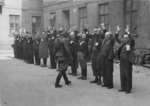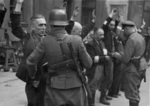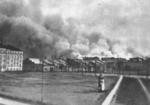Warsaw Ghetto Uprising
Contributor: John Radzilowski
ww2dbaseImmediately following the Nazi attack on the Soviet Union, German authorities began to implement the mass killing of Jews in occupied Poland. The first to be killed were in the regions of eastern Poland occupied by the Soviet Union in 1939. As German forces moved into this region they were followed by Einsatzgruppen, or mobile killing squads which began the mass killing of Jews in villages and small towns. By late 1942, German methods of extermination had been considerably refined. Gas chambers were put into use and Jews who had earlier been isolated from the gentile population were shipped en mass to killing centers such as Treblinka.
ww2dbaseMost Jews had neither the time nor the resources to mount serious resistance to the German killing operations. In most cases it happened too quickly. But in the larger Ghettos, such as Warsaw, small groups of Jews began organizing resistance cells with the goal of fighting back. The most extensive network of cells arose in Warsaw.
ww2dbaseJewish resistance was deeply divided along political lines and in the beginning quite small. The best organized were the right-wing Zionist revisionists of the Jewish Fighting Union (known by its Polish acronym, ZZW). Many were veterans of the Polish army and maintained good ties to their gentile comrades who were active in the Polish resistance. Nevertheless, this group was often shunned by left-leaning groups.
ww2dbaseThe best-known group was the Jewish Fighting Organization (or ŻOB, its Polish acronym), made up primarily of members of the Zionist youth movements Akiva, Dror, Hashomer Hatzair, and Hechalutz. ZOB’s teenage activists were largely untrained and were not trusted by Polish underground authorities due to the fact that some held strong pro-Soviet views. The socialist Bund also had an effective fighting unit.
ww2dbaseAs the deportations to the death camps continued in early 1943, these small resistance units began to mobilize. The Polish underground had no way to provide the Jews with the heavy weapons needed to fight the Germans effectively and so provided aid in the form of money so arms could be purchased on the black market. In addition, it provided some small caches of arms. (Decades later, this decision and the Polish underground’s goal of waiting for a national uprising when Germany was on the verge of defeat would be the subject of bitter criticism by many Western writers.) Jewish resistance cells began to target collaborators, blackmailers, and leaders of the infamous Jewish Ghetto Police. In Jan 1943 there was a brief clash with German police.
ww2dbaseAs conditions in the Warsaw Ghetto worsened, deportations increased. By Apr 1943, only 70,000 Jews remained in the Ghetto. The Germans prepared for the final push to “liquidate” the Ghetto.
ww2dbaseIn the early morning of 19 Apr 1943, police troops of the Waffen SS supported by a tank entered the Ghetto, but this time the “helpless” Jews fought back, putting the tank out of action and driving the SS men out of the Ghetto. At dawn, the people of Warsaw were electrified to see the blue and white flag of a future Israel and the Polish red and white flying over the Ghetto. Additional German forays into the Ghetto were repulsed as well. For the “master race,” this was a humiliating come down. The Germans then attacked the Ghetto in force, using incendiaries and artillery to set buildings on fire, but still they met furious resistance.
ww2dbaseThe fiercest struggles occurred on 22-23 Apr. Fighters of the Jewish socialist Bund mounted heroic resistance in the Brushmaker’s Area, many of their leaders perishing at their posts. At Muranów Square, the right-wing ZZW assisted by members of the Polish Home Army (AK), held off the Nazis for four days. The German commander conceded: “The stiffest resistance was offered by a rebel group . . . at 7 Muranowska Street. This position held out longer than any other . . . The rebels were able to obtain a constant supply of ammunition furnished them by a Polish resistance group. The attacks launched by our forces on this position were repeatedly repelled.”
ww2dbaseBy the fourth day of the uprising, large sections of the ghetto were on fire. Many fighters and civilians perished in the flames and the collapsing building. Fighting became sporadic, though German patrols continued to take losses even into early May. Some fighters and civilians managed to escape the Ghetto and find shelter outside. On 16 May, the Germans declared victory by blowing up the Ghetto’s remaining synagogue. They officially admitted less than 100 casualties, though Polish underground sources estimated Nazi losses at closer to 1000. Jewish losses were approximately 6,000 along with 55 fighters of the AK. This heroic, doomed resistance, however, had demonstrated the tenacity of the Jewish people and the utter depravity of the Nazi regime. It would be remembered as one of the bravest struggles ever undertaken by a people faced with destruction.
ww2dbaseSources: Destruction of the European Jews, the Forgotten Holocaust, Traveller’s History of Poland.
Last Major Update: Feb 2006
Warsaw Ghetto Uprising Interactive Map
Photographs
 |  |  |  |
Warsaw Ghetto Uprising Timeline
| 19 Apr 1943 | Waffen-SS used tanks and other heavy weapons to counter the uprising at the Jewish ghetto in Warsaw, Poland, killing and deporting at least 50,000 during the following 27 days. |
| 25 Apr 1943 | JĂĽrgen Stroop reported that 27,464 Jews had been captured in the Jewish ghetto of Warsaw, Poland. |
| 26 Apr 1943 | JĂĽrgen Stroop reported that, in the effort to liquidate the Warsaw ghetto in Poland, 1,330 Jews had been pulled out of their strongholds and killed, 662 were killed in combat, and 30 were captured and sent to concentration camps. |
| 16 May 1943 | The Warsaw Ghetto Uprising ended in Poland with the destruction of the Warsaw synagogue at 2015 hours. In JĂĽrgen Stroop's final daily report, he noted that 180 Jewish fighters were killed on this final day. |
Did you enjoy this article or find this article helpful? If so, please consider supporting us on Patreon. Even $1 per month will go a long way! Thank you. Share this article with your friends: Stay updated with WW2DB: |
Visitor Submitted Comments
26 Apr 2017 09:18:50 AM
My cousin from Lodz Poland watch as they took his wife just born daughter two sisters and his mother walk them to train and gas to death. he than work in ammunition plant but was bomb than shoes factory only for pos Hitler well 1945 he got liberated by American troops
All visitor submitted comments are opinions of those making the submissions and do not reflect views of WW2DB.
» Blösche, Josef
» Stroop, JĂĽrgen
Location:
» Poland
Related Book:
» Isaac's Army
- » 1,150 biographies
- » 337 events
- » 43,917 timeline entries
- » 1,241 ships
- » 350 aircraft models
- » 207 vehicle models
- » 374 weapon models
- » 123 historical documents
- » 260 facilities
- » 470 book reviews
- » 28,540 photos
- » 432 maps
Joachim von Ribbentrop, German Foreign Minister, Aug 1939
Please consider supporting us on Patreon. Even $1 a month will go a long way. Thank you!
Or, please support us by purchasing some WW2DB merchandise at TeeSpring, Thank you!
7 Jan 2016 03:43:13 AM
Reichsführer-SS Himmler was so enraged by the failure, on April 19, 1943, to clear the remaining Jews out of the Ghetto that he sacked the officer in charge, Oberführer von Sammern–Frankenegg on the spot. The replacement, Waffen-SS Brigadeführer Jürgen Stroop, was brought in from a Police command in Greece but faced with tough armed resistance and able to call upon a mixed force of some two thousand men, many untrained as soldiers and made up of riff-raff from renegade Latvians and Lithuanians bolstered by two training battalions of Waffen–SS would take, with heavy losses, an incredible thirty-five days to eliminate the Jewish resistance within the Ghetto.